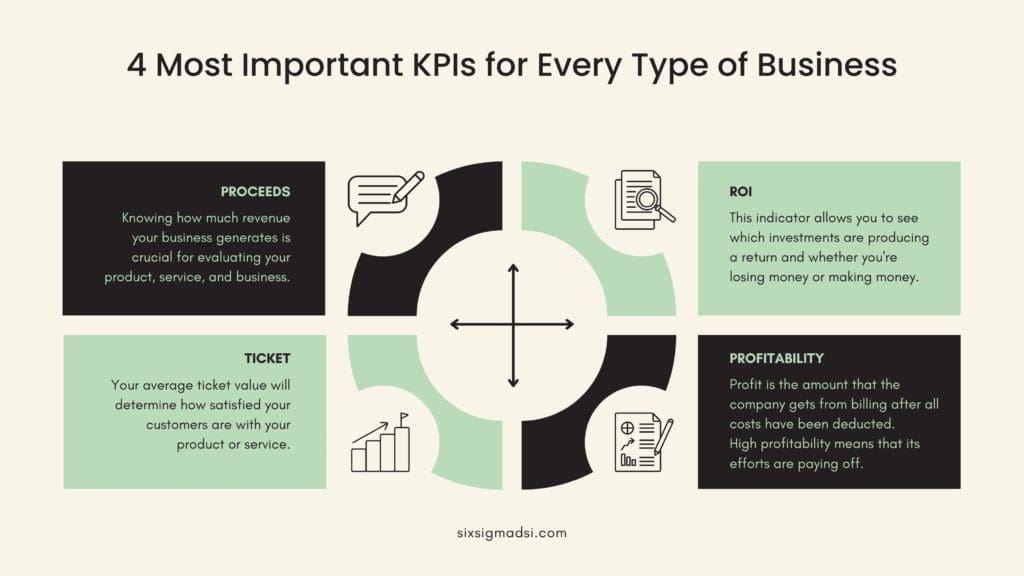Table of contents
Six Sigma Key Performance Indicators (KPIs)
Lean Six Sigma Key Performance Indicators (KPI) are management tools for the measurement and reporting of metrics on the success of a company or website. Indicators are also important to keep you focused and not lose sight of the decision-making.
KPIs are designed to reveal everything about a company’s influence on it and provide direction.
It is important to understand how to identify which metrics are most relevant to your business. Not every metric is a key performance indicator. When a metric is critical to the analysis of your company, it becomes a Lean Key Performance Indicator (KPI).
It is important to “evaluate & reevaluate” metrics in order to evaluate them. This means that it is necessary to assess how well a strategy is functioning and to compare metrics used as a reference with the new metrics after an improvement.
There are many tools that can be used to calculate the performance index. Each tool is specific to a business type.
Six Sigma KPI’s Should de SMART
S – Specific
Specificity is key to achieving a goal. It is essential that everyone involved in the elaboration of it has a clear understanding of what they will be working on, and how to define it objectively and clearly.
Are you a believer that increasing revenue is a worthwhile goal? It might be a useful objective, but it is not a goal. is, as we have said, a combination of qualitative and quantitative aspects.
It is not logical to set a goal of increasing revenue alone. You need to include numerical factors that can give you greater accuracy in achieving your goals.
A specific goal also takes into consideration several factors such as:
- Who will make this increase possible?
- What will it take?
- Why should it be done?
- It will happen where?
M – Measurable
The quantitative elements are used to compare, evaluate, and monitor the goal. It is crucial that the goal is quantifiable.
Let’s say, for example, that we want to increase sales by 19% within a 4-month period.
It is impossible to track the progress of the goal without knowing the exact amount and time it will take.
A – Achievable
It is essential that a goal be achievable. It is easy to see that this is obvious. However, many companies fail to define their goals because they don’t know their true potential.
A company that sets a goal that is not achievable is very dangerous and can discourage the group.
It can be frustrating to spend months creating strategies and action plans, mobilizing your team, and not getting the results you desire.
The company’s past data must be considered when defining a goal. To determine where the organization can go, you need to understand where it has been.
Also, it is important to agree with the work group on the defined values deadlines. It is acceptable to set a goal if it is achievable based on all of the knowledge and qualifications available to the team. However, it is important to revisit it.
R – Relevant
It is important to evaluate the relevance of the goal to the business after defining it and mobilizing the planning team.
A pertinent goal is one that has a direct impact on the business and produces a positive return for the company. It must be justified and help the company grow and evolve.
To help you define the relevant goals, it is important to analyze the following indicators: number of customers in the database, sales volume, cost of customer acquisition (CAC), and profit generated.
T – Timebound
Without establishing a time frame to achieve the goal, it is impossible to make it attainable.
We saw that all tasks must be completed by a certain date, as we learned in the measurement phase in Six Sigma.
Time is an important factor in a company’s success, so it must know how to manage it well. Your finances will be devastated if you don’t have a deadline for achieving your goal. Remember the old saying Time is Money.

What Types of Key Performance Indicators (KPIs) are There?
There are two types of Lean Six Sigma: volume metrics, and efficiency measures.
The first shows its results as absolute values, while the second measures them in percentage.
Both metrics should be combined because each type of analysis will have a high chance of error during interpretation.
If you make a website load faster and you then notice an increase in visits to the site, it is not a sign that there is a direct correlation.
You can take many actions to increase the sales of your products and services. However, it is important to do a thorough analysis in order to ensure you are on the right path.
Projects are often viewed as something large and complex. It is wrong to think that a project must involve large-scale activities every day. Some examples include negotiating with suppliers, delivering goods, and implementing strategies and systems. Good project management can bring benefits to an organization and be used to solve problems. Good project management will clearly define the decision-making process and identify causes and consequences.
What’s the Difference Between Metrics and KPIs?
Many people are confused about the terms KPIs and metrics. They don’t know how to distinguish the two. In Lean Six Sigma, metrics can be a KPI depending on their relevance to your business.
A metric can be described as an analysis that uses only objective and raw data. This is different from KPIs which can contain multiple metrics or be built from one metric.
In Lean Six Sigma, a metric is an analysis that is not usually associated with a conversion measurement. KPIs are, however, directly related to a measurement that seeks lead conversion.
One example of a metric in Lean Six Sigma is the number of visits to your website, on social media networks, or the bounce rate for your product or services.
KPIs could include conversion rates of customers, the user stay rate on your website, or even profit for the company.
Next, we’ll learn about the KPI performance indicators and how they are broken down into results indicators.
5 Lean KPI Indicators
You can use lean Six Sigma KPI anywhere you are in the process of measuring your results. These indicators are:
1. Qualitative indicators
This indicator determines the quality product to be made available to the public. The ideal product or service is perfect.
2. Indicators of productivity
This indicator will show the relationship between the outputs of an activity/work and the resources used.
It can be used for Six Sigma measurement performance in relation to other workers, but it does not have to be tied to materials.
3. Indicators of effectiveness:
It is a different name than the ones we have already mentioned and exemplifies efficiency along with the effectiveness of products and services.
4. Indicators of capacity
This indicator indicates the ability to produce the process of analyzing inputs or outputs in a specified time period.
5. Strategic indicators
We also have indicators that indicate how far the organization has moved in the right direction.
They also transmit performance in relation to crucial success factors.
The Most Important Lean Six Sigma KPI Metrics for Every Type of Business

First, it’s important to stress that every type of business has different needs. In Lean Six Sigma, metrics that are highly recommended for one company might not be applicable to another.
There are, however, metrics that capture more information than is normal for every company. These metrics are:
1. Proceeds
Revenue is the amount of money that has been earned through the sale or purchase of financial products, applications, or services.
This analysis allows you to compare your results with the market averages and will help you determine if you should invest in a specific sector. Knowing how much revenue your business generates is crucial for evaluating your product, service, and business.
Add all billings you have during the period to calculate.
2. Ticket
The average customer spends the most in a given company. This indicator is vital as it will tell you whether your customers are still purchasing products and services from your company.
Your average ticket value will determine how satisfied your customers are with your product or service.
Calculate the total sales value for the period/total sales.
3. ROI
Return on Investment (or ROI) is an indicator of the return on investment.
This indicator allows you to see which investments are producing a return and whether you’re losing money or making money.
4. Profitability
Profit is the amount that the company gets from billing after all costs have been deducted. The other definition of profitability is the percentage of revenue that a business can earn.
High profitability means that a company’s return on investment is high and that its efforts are paying off.
How do you calculate it? Net profit / Total Revenue*100
Which is the most important Six Sigma KPI measurement for your project?
Tell us in the comments below.



















